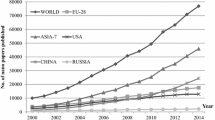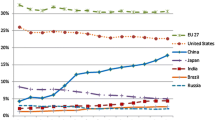Abstract
In this paper we compare the scientific research in the semiconductor-related field in China with some other major nations in Asia. It is based on the bibliometric information from SCI-Expanded database during the time period of 1995–2004. We show that China has been developing fast in semiconductor research, and become the second productive country in Asia as reflected by the publication profile. The evidences indicate a significant increasing trend in the research efforts and readership among Asian countries. Similar to the scientists in Japan and South Korea, Chinese scientists were more inclined to work in larger groups, typically 4 or more authors. The assessment of research quality is further conducted based on citation-based measures. As benchmarks, two western countries, namely USA and Germany, have been compared in the citation analysis. It is revealed that the impacts of research outputs in the Asian countries, except for Japan, have been badly incommensurate with their devoted research efforts compared with USA and Germany. Like most of other Asian countries the research results of Chinese scientists in semiconductor have a low international visibility despite their strong research efforts and increasingly large domestic readership. The application of Leimkuhler curve illustrates vividly the inequality of citation times among the compared countries. Furthermore, the Gini Indices of each country and each pair of countries are calculated which illustrates again the inequality of informetric productivities.
Similar content being viewed by others
References
Borgman, C. L. (Ed.) (1990), Scholarly Communication and Bibliometrics. Newbury Park, CA: Sage.
Braun, T., Glänzel, W., Schubert, A. (1988), World flash on basic research: The newest version of the facts and figures on publication output and relative citation impact of 100 countries: 1981–1985. Scientometrics, 13(5–6): 181–188.
Braun, T., Glänzel, W., Schubert, A. (1991). The bibliometric assessment of UK scientific performance — some comments on Martin’s reply. Scientometrics, 20: 359–362.
Burrell, Q. L. (1991), The Bradford distribution and the Gini index. Scientometrics, 21: 181–194.
Burrell, Q. L. (1992), The Gini index and the Leimkuhler curve for bibliometric processes. Information Processing & Management, 28(1): 19–33.
Burrell, Q. L. (2005), Measuring similarity of concentration between different informetrics distributions: Two new approaches. Journal of the American Society for Information Science and Technology, 56(7): 704–714.
Cole, S., Rubin, L., Cole, J. R. (1978), Peer Review in the National Science Foundation, National Academy of Sciences. Washington D.C.
Cronin, B. (1984), The Citation Process: The Role and Significance of Citations in Scientific Communication. London: Taylor Graham.
Cronin, B., Overfelt, K. (1994), Citation-based auditing of academic performance. Journal of American Society for Information Science, 45(2): 61–72.
Cronin, B., Shaw, D., La Barre, K. (2003), A cast of thousands: Coauthorship and subcoauthorship collaboration in the 20th century as manifested in the scholarly journal literature of psychology and philosophy. Journal of the American Society for Information Science and Technology, 54(9): 855–871.
Dagum, C. (1987), Measuring the economic affluence between populations of income receivers. Journal of Business and Economic Statistics, 5: 5–11.
Frame, J. D. (1977), Mainstream research in Latin America and Caribbean. Interciencia, 2: 143–148.
Garfield, E. (1979), Citation Indexing — Its Theory and Applications in Science, Technology and Humanities. New York: Wiley.
Garg, K. C. (2002), Scientometrics of laser research in India and China. Scientometrics, 55(1): 71–85.
Guan, J. C., Ma, N. (2004), A comparative study of research performance in computer science. Scientometrics, 61(3): 339–359.
Guan, J. C., He, Y. (2005), Comparison and evaluation of domestic and international outputs in information science & technology research of China. Scientometrics, 65(2): 215–244.
Hawkins, D. T. (1976), Semiconductor journals. Journal of Chemical Information and Computer Sciences, 16(1): 21–23. http://www.semi.org
Jin, B. H., Rousseau, R. (2004), Evaluation of research performance and scientometric indicators in China. In: Moed, H. F., Glänzel, W., Schmoch, U. (Eds) (2004), Handbook of Quantitative Science and Technology Research. Dordrecht: Kluwer Publishers, pp. 497–514.
King, D. A. (2004), The scientific impact of nations. Nature, 430: 311–316.
Lim, K. (2004), The relationship between research and innovation in the semiconductor and pharmaceutical industries (1981–1997). Research Policy, 33: 287–321.
Lotka, A. J. (1926), The frequency distribution of scientific productivity. Journal of the Washington Academy of Sciences, 16: 317–323.
Martin, B. R., Irvine, J. (1983), Assessing basic research. Some partial indicators of scientific progress in radio astronomy. Research Policy, 12: 61–90.
Merton, R. K. (1972), The institutional imperatives of science. In: Barnes, B. S. (Ed.), The Sociology of Science. New York: Pengium.
Moed, H. F., Burger, W. J. M., Frankfort, J. G., Van Raan, A. F. J. (1985), The use of bibliometric data for the measurement of university research performance. Research Policy, 14: 131–149.
Moed, H. F., Luwel, M., Nederhof, A. J. (2002), Towards research performance measurement in the humanities. Library Trends, 50: 498–520.
Moed, H. F. (2002), Measuring China’s research performance using the Science Citation Index. Scientometrics, 53(3): 281–296.
Narin, F. (1976), Evaluative Bibliometrics: The Use of Publication and Citation Analysis in the Evaluation of Scientific Activity. Cherry Hill, NJ: Computer Horizons, Inc.
Posner, R. A. (2001), Public Intellectual: A Study of Decline. Cambridge, MA: Harvard University Press.
Price, D. J. De Solla (1963), Little Science, Big Science. New York: Columbia University Press.
Ren, S. L., Rousseau, R. (2002), International visibility of Chinese scientific journals. Scientometrics, 53(3): 389–405.
Rinia, E. J., Van Leeuwen, Th. N., Van Vuren, H. G., Van Raan, A. F. J. (1998), Comparative analysis of a set of bibliometric indicators and central peer review criteria: Evaluation of condensed matter physics in the Netherlands. Research Policy, 27: 95–107.
Schubert, A., Braun, T. (1986), Relative indicators and relational charts for comparative assessment of publication output and citation impact. Scientometrics, 9: 281–291.
Tsay, M. Y., Jou, S. J., Ma, S. S. (2000), A bibliometric study of semiconductor literature, 1978–1997. Scientometrics, 49(3): 491–509.
Tsay, M. Y., Ma, S. S. (2002), The nature and relationship between the productivity of journals and their citations in semiconductor literature. Scientometrics, 56(2): 201–222.
Tsay, M. Y., Xu, H., Wu, C. W. (2003), Journal co-citation analysis of semiconductor literature. Scientometrics, 57(1): 7–25.
Van Raan, A. F. J., Van Leeuwen, Th. N. (2002), Assessment of the scientific basis of interdisciplinary, applied research, Application of bibliometric methods in nutrition and food research. Research Policy, 31: 611–632.
Van Raan, A. F. J. (2004), Measuring science. Capita selecta of current main issues. In: Moed, H. F., Glänzel, W., Schmoch, U. (Eds) (2004), Handbook of Quantitative Science and Technology Research. Dordrecht: Kluwer Publishers, pp. 19–50.
Wang, J. X., Guan, J. C. (2005), The analysis and evaluation of knowledge efficiency in research groups. Journal of the American Society for Information Science and Technology, 56(11): 1217–1226.
Author information
Authors and Affiliations
Corresponding author
Rights and permissions
About this article
Cite this article
Guan, J., Ma, N. A bibliometric study of China’s semiconductor literature compared with other major asian countries. Scientometrics 70, 107–124 (2007). https://doi.org/10.1007/s11192-007-0107-7
Received:
Issue Date:
DOI: https://doi.org/10.1007/s11192-007-0107-7




